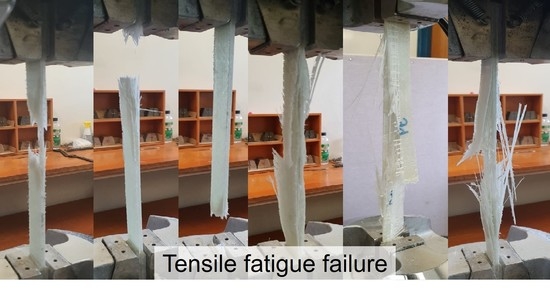Tensile Fatigue Behavior of Polyester and Vinyl Ester Based GFRP Laminates—A Comparative Evaluation
Abstract
1. Introduction
2. Materials and Methods
2.1. Materials
2.2. Justification of Selecting Parameters
2.3. Test Setup
3. Results and Discussion
3.1. Ultimate Strength and Stiffness
3.2. Fatigue Failure Mode
3.3. Effect of Resin Types
3.4. Effect of Stress Ratio
3.5. Effect of Water Absorption
4. Fatigue Model
5. Conclusions
Author Contributions
Funding
Institutional Review Board Statement
Informed Consent Statement
Data Availability Statement
Acknowledgments
Conflicts of Interest
References
- Gaurav, A.; Singh, K.K. Fatigue behavior of FRP composites and CNT-Embedded FRP composites: A review. Polym. Compos. 2018, 39, 1785–1808. [Google Scholar] [CrossRef]
- Ansari, M.T.A.; Singh, K.K.; Azam, M.S. Fatigue damage analysis of fiber-reinforced polymer composites—A review. J. Reinf. Plast. Compos. 2018, 37, 636–654. [Google Scholar] [CrossRef]
- Ferdous, W.; Bai, Y.; Ngo, T.D.; Manalo, A.; Mendis, P. New advancements, challenges and opportunities of multi-storey modular buildings—A state-of-the-art review. Eng. Struct. 2019, 183, 883–893. [Google Scholar] [CrossRef]
- Ferdous, W.; Bai, Y.; Almutairi, A.D.; Satasivam, S.; Jeske, J. Modular assembly of water-retaining walls using GFRP hollow profiles: Components and connection performance. Compos. Struct. 2018, 194, 1–11. [Google Scholar] [CrossRef]
- Mohammed, A.A.; Manalo, A.; Ferdous, W.; Zhuge, Y.; Vijay, P.; Alkinani, A.Q.; Fam, A. State-of-the-art of prefabricated FRP composite jackets for structural repair. Eng. Sci. Technol. Int. J. 2020. [Google Scholar] [CrossRef]
- Ferdous, W.; Manalo, A.; Van Erp, G.; Aravinthan, T.; Ghabraie, K. Evaluation of an Innovative Composite Railway Sleeper for a Narrow-Gauge Track under Static Load. J. Compos. Constr. 2018, 22, 04017050. [Google Scholar] [CrossRef]
- Mohammed, A.A.; Manalo, A.C.; Ferdous, W.; Zhuge, Y.; Vijay, P.; Pettigrew, J. Experimental and numerical evaluations on the behaviour of structures repaired using prefabricated FRP composites jacket. Eng. Struct. 2020, 210, 110358. [Google Scholar] [CrossRef]
- Al-Rubaye, M.; Manalo, A.; Alajarmeh, O.; Ferdous, W.; Lokuge, W.; Benmokrane, B.; Edoo, A. Flexural behaviour of concrete slabs reinforced with GFRP bars and hollow composite reinforcing systems. Compos. Struct. 2020, 236, 111836. [Google Scholar] [CrossRef]
- Zangana, S.; Epaarachchi, J.; Ferdous, W.; Leng, J. A novel hybridised composite sandwich core with Glass, Kevlar and Zylon fibres—Investigation under low-velocity impact. Int. J. Impact Eng. 2020, 137, 103430. [Google Scholar] [CrossRef]
- Ferdous, W.; Manalo, A.; Alajarmeh, O.; Mohammed, A.A.; Salih, C.; Yu, P.; Khotbehsara, M.M.; Schubel, P. Static behaviour of glass fibre reinforced novel composite sleepers for mainline railway track. Eng. Struct. 2021, 229, 111627. [Google Scholar] [CrossRef]
- Nardone, F.; Di Ludovico, M.; Basalo, F.J.D.C.Y.; Prota, A.; Nanni, A. Tensile behavior of epoxy based FRP composites under extreme service conditions. Compos. Part B Eng. 2012, 43, 1468–1474. [Google Scholar] [CrossRef]
- Lekou, D.; Philippidis, T. Mechanical property variability in FRP laminates and its effect on failure prediction. Compos. Part B Eng. 2008, 39, 1247–1256. [Google Scholar] [CrossRef]
- Benmokrane, B.; Ali, A.H.; Mohamed, H.M.; Elsafty, A.; Manalo, A. Laboratory assessment and durability performance of vinyl-ester, polyester, and epoxy glass-FRP bars for concrete structures. Compos. Part B Eng. 2017, 114, 163–174. [Google Scholar] [CrossRef]
- Bennett-Huntley, E. Epoxy Resin vs. Vinylester vs. Polyester—Use and Application Overview; Composite Resin Developments: London, UK, 2014. [Google Scholar]
- Ali, A.H.; Benmokrane, B.; Mohamed, H.M.; Manalo, A.; El-Safty, A. Statistical analysis and theoretical predictions of the tensile-strength retention of glass fiber-reinforced polymer bars based on resin type. J. Compos. Mater. 2018, 52, 2929–2948. [Google Scholar] [CrossRef]
- Keller, T.; Tirelli, T.; Zhou, A. Tensile fatigue performance of pultruded glass fiber reinforced polymer profiles. Compos. Struct. 2005, 68, 235–245. [Google Scholar] [CrossRef]
- Vieira, P.R.; Carvalho, E.M.L.; Vieira, J.D.; Filho, R.D.T. Experimental fatigue behavior of pultruded glass fibre reinforced polymer composite materials. Compos. Part B Eng. 2018, 146, 69–75. [Google Scholar] [CrossRef]
- Borrego, L.; Costa, J.; Ferreira, J.; Silva, H. Fatigue behaviour of glass fibre reinforced epoxy composites enhanced with nanoparticles. Compos. Part B Eng. 2014, 62, 65–72. [Google Scholar] [CrossRef]
- Siddika, A.; Al Mamun, A.; Ferdous, W.; Alyousef, R. Performances, challenges and opportunities in strengthening reinforced concrete structures by using FRPs—A state-of-the-art review. Eng. Fail. Anal. 2020, 111, 104480. [Google Scholar] [CrossRef]
- Swain, S.; Beura, S.; Thatoi, D.; Chakraverty, A.; Mohanty, U. Durability of GFRP composite exposed to outdoors weathering. Compos. Commun. 2019, 13, 22–29. [Google Scholar] [CrossRef]
- Liew, Y.S.; Tan, K.H. Durability of gfrp composites under tropical climate. In Fibre-Reinforced Polymer Reinforcement for Concrete Structures; World Scientific: Singapore, 2003; Volume 2, pp. 769–778. [Google Scholar]
- Aboelseoud, M.A.; Myers, J.J. Durability of Hybrid Composite Beam Bridges Subjected to Various Environmental Conditioning. J. Compos. Constr. 2016, 20, 04016045. [Google Scholar] [CrossRef]
- ASTM. ASTM-D3171, Standard Test Methods for Constituent Content of Composite Materials; ASTM International: West Conshohocken, PA, USA, 2015. [Google Scholar]
- ASTM. ASTM-D3039, Standard Test Method for Tensile Properties of Polymer Matrix Composite Materials; ASTM International: West Conshohocken, PA, USA, 2017. [Google Scholar]
- ISO. ISO-13003, Fibre-Reinforced Plastics—Determination of Fatigue Properties under Cyclic Loading Conditions; International Organization for Standardization: Geneva, Switzerland, 2003. [Google Scholar]
- Boinard, E.; Pethrick, R.A.; Dalzel-Job, J.; Macfarlane, C.J. Influence of resin chemistry on water uptake and environmental ageing in glass fibre reinforced composites-polyester and vinyl ester laminates. J. Mater. Sci. 2000, 35, 1931–1937. [Google Scholar] [CrossRef]
- Ferdous, W.; Manalo, A.; Peauril, J.; Salih, C.; Reddy, K.R.; Yu, P.; Schubel, P.; Heyer, T. Testing and modelling the fatigue behaviour of GFRP composites—Effect of stress level, stress concentration and frequency. Eng. Sci. Technol. Int. J. 2020, 23, 1223–1232. [Google Scholar] [CrossRef]
- Quino, G.; Tagarielli, V.; Petrinic, N. Effects of water absorption on the mechanical properties of GFRPs. Compos. Sci. Technol. 2020, 199, 108316. [Google Scholar] [CrossRef]


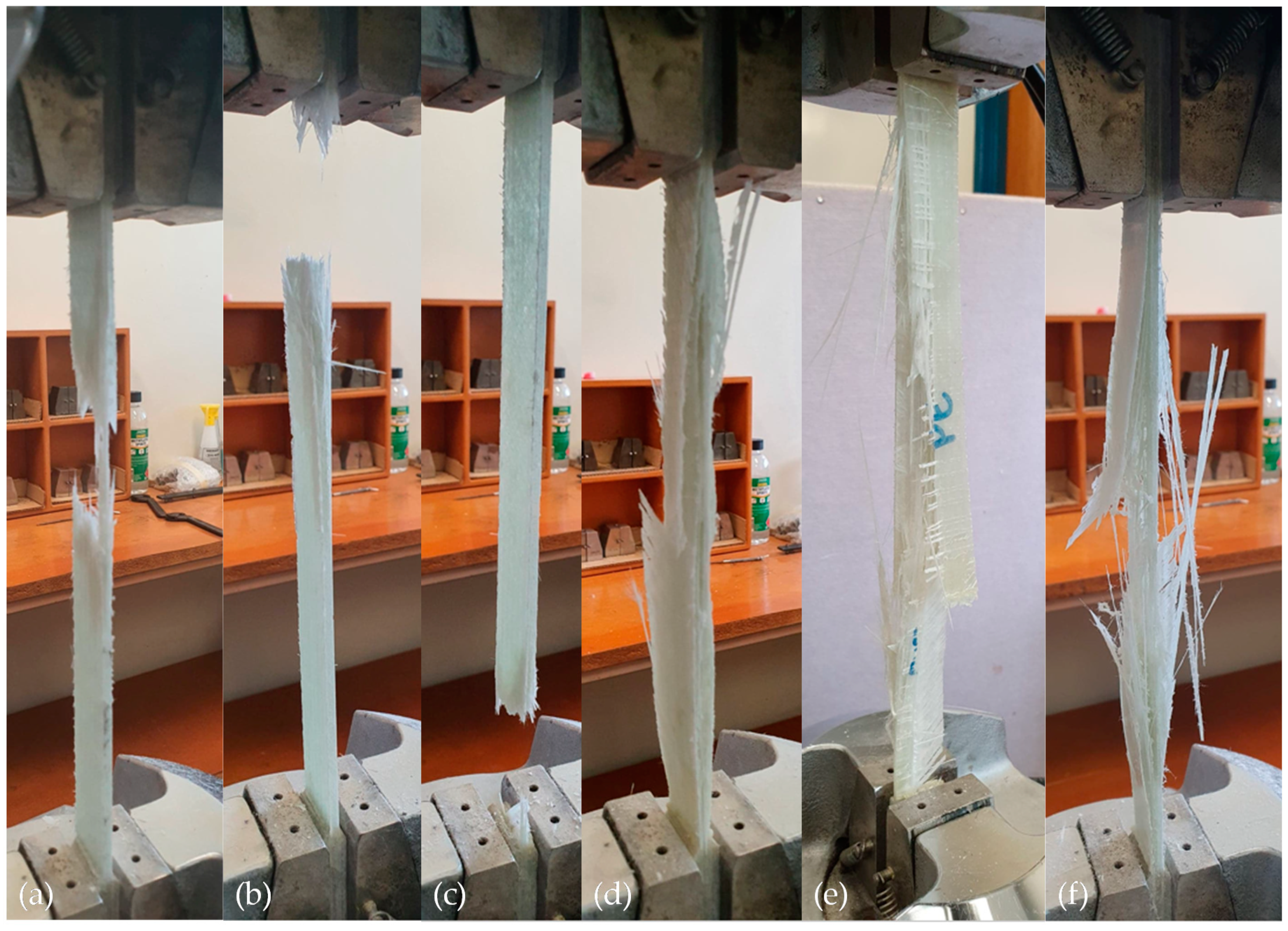
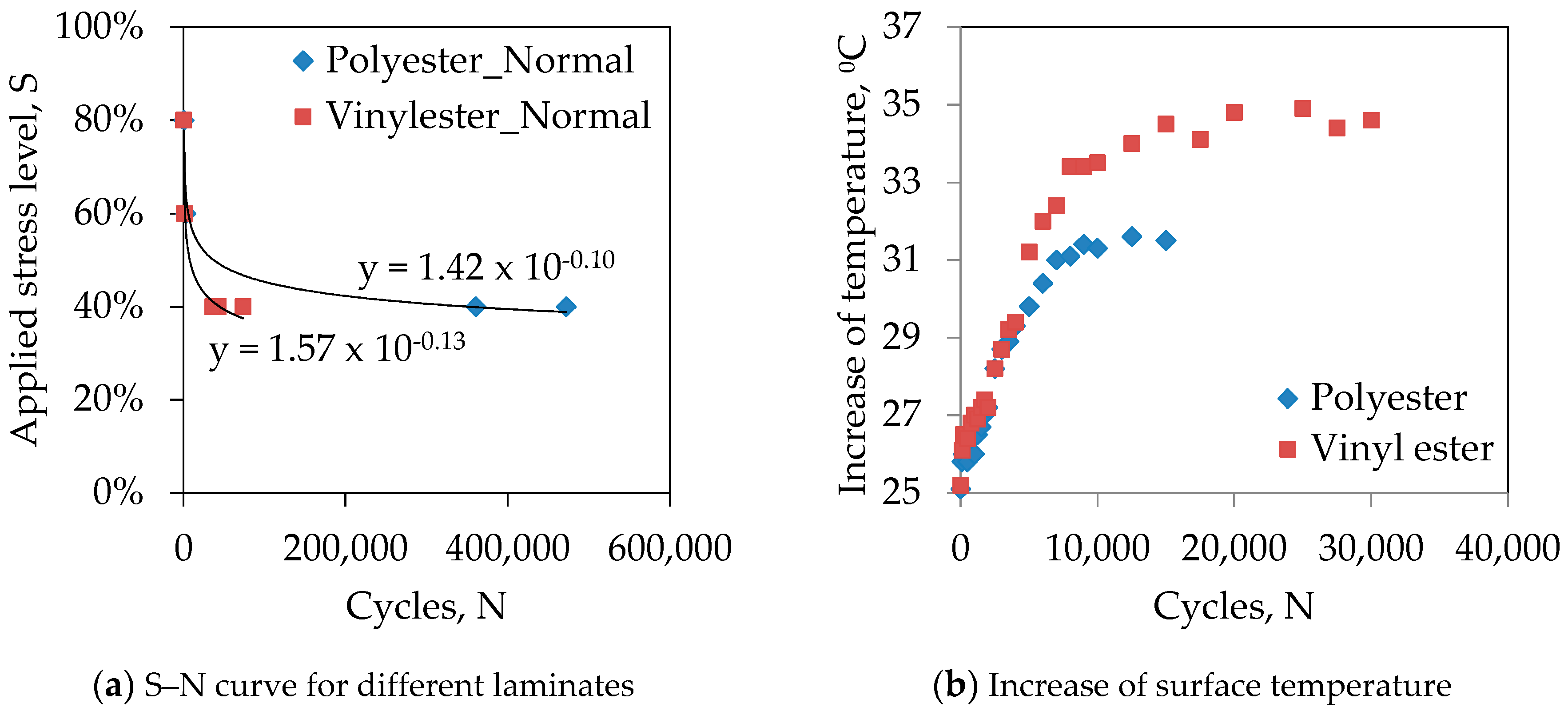
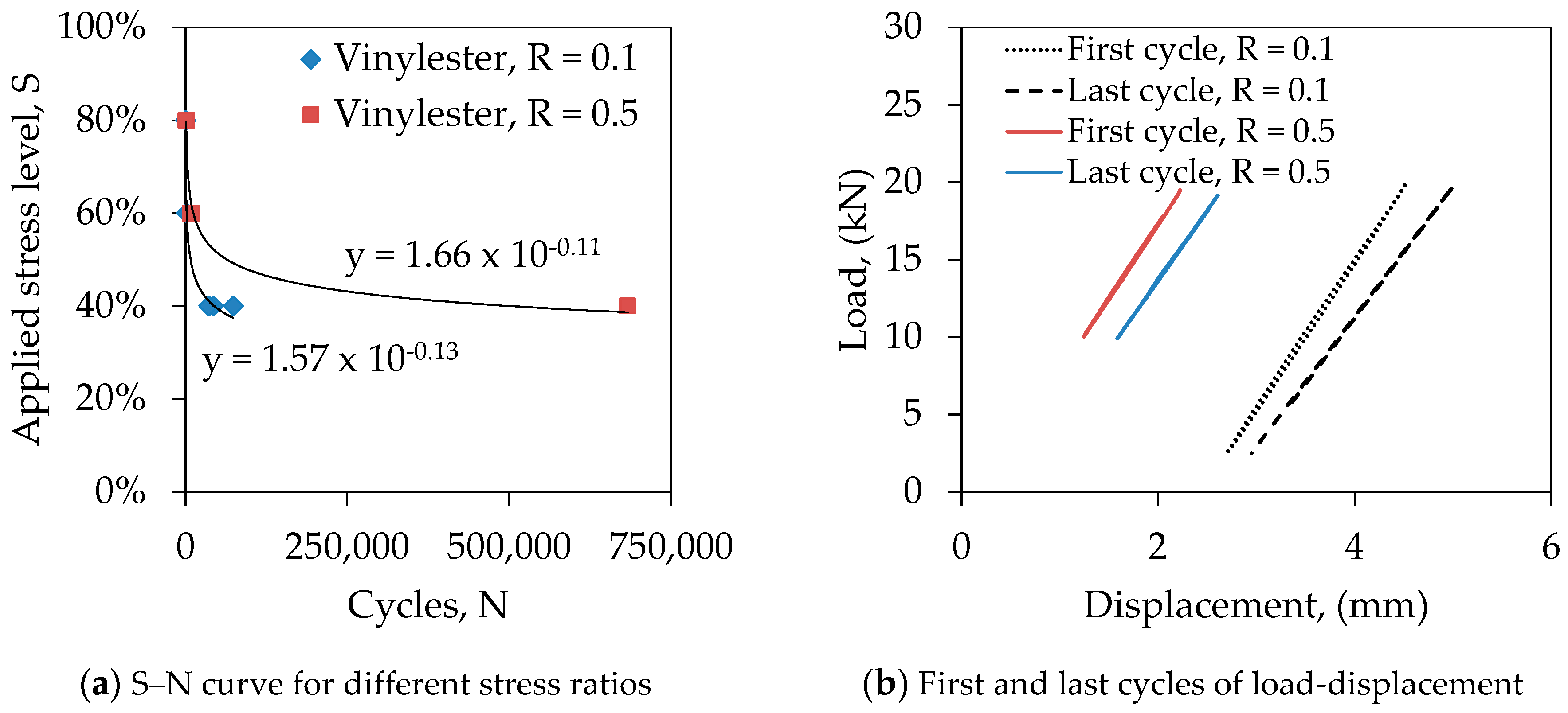

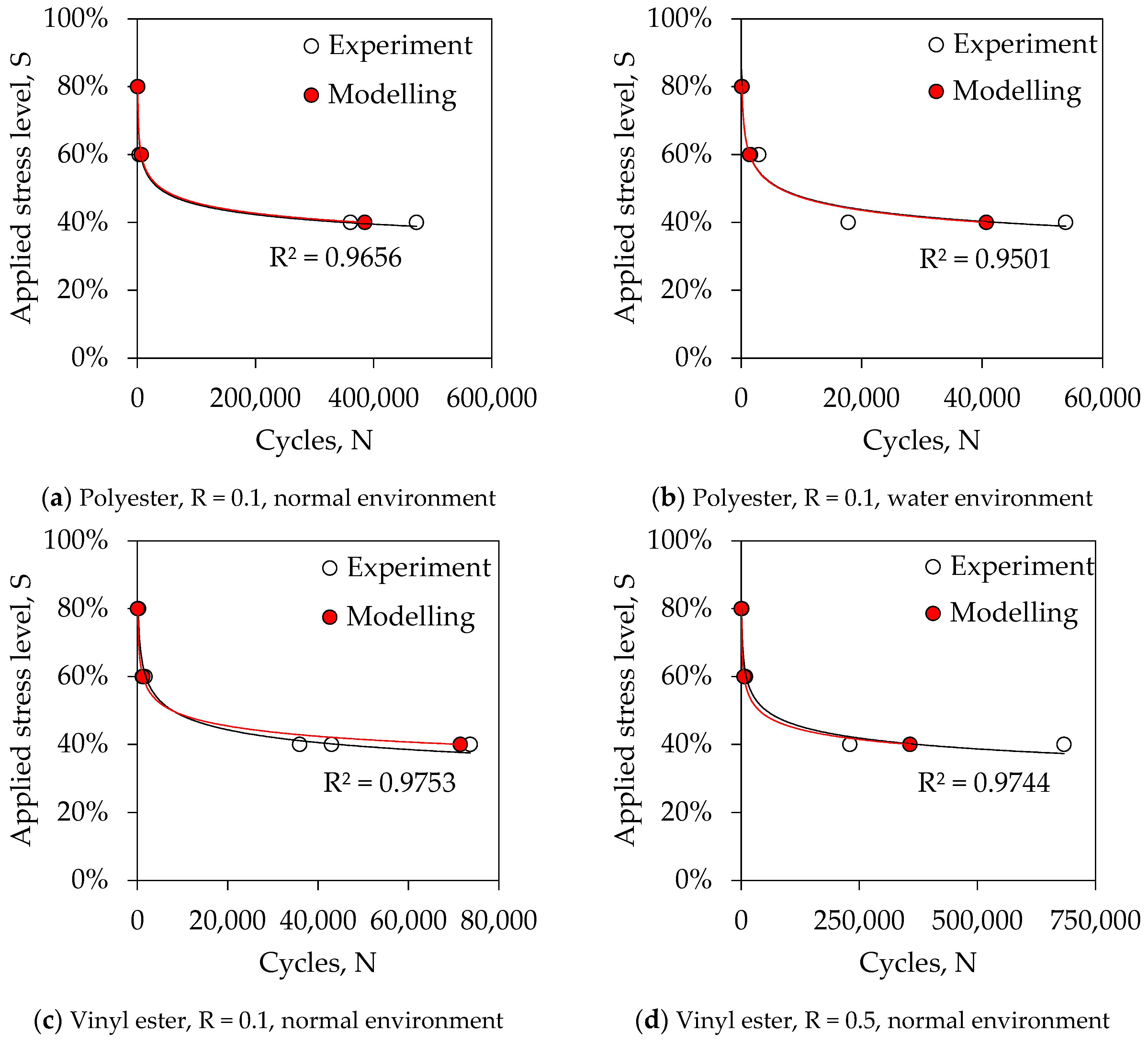
| Sample Name | Types of Resin | Stress Ratio, R | Environmental Conditions | Applied Max Stress Level, S | No. of Tested Samples | Failure Modes |
|---|---|---|---|---|---|---|
| RPR0.1ENS80 | Polyester | 0.1 | Normal | 80% | 3 | Figure 3b |
| RPR0.1ENS60 | Polyester | 0.1 | Normal | 60% | 3 | Figure 3b |
| RPR0.1ENS40 | Polyester | 0.1 | Normal | 40% | 2 | Figure 3f |
| RPR0.1EWS80 | Polyester | 0.1 | Water | 80% | 3 | Figure 3d |
| RPR0.1EWS60 | Polyester | 0.1 | Water | 60% | 3 | Figure 3d |
| RPR0.1EWS40 | Polyester | 0.1 | Water | 40% | 2 | Figure 3e |
| RVR0.1ENS80 | Vinyl ester | 0.1 | Normal | 80% | 3 | Figure 3c |
| RVR0.1ENS60 | Vinyl ester | 0.1 | Normal | 60% | 3 | Figure 3c |
| RVR0.1ENS40 | Vinyl ester | 0.1 | Normal | 40% | 2 | Figure 3b |
| RVR0.5ENS80 | Vinyl ester | 0.5 | Normal | 80% | 3 | Figure 3c |
| RVR0.5ENS60 | Vinyl ester | 0.5 | Normal | 60% | 3 | Figure 3c |
| RVR0.5ENS40 | Vinyl ester | 0.5 | Normal | 40% | 2 | Figure 3a |
Publisher’s Note: MDPI stays neutral with regard to jurisdictional claims in published maps and institutional affiliations. |
© 2021 by the authors. Licensee MDPI, Basel, Switzerland. This article is an open access article distributed under the terms and conditions of the Creative Commons Attribution (CC BY) license (http://creativecommons.org/licenses/by/4.0/).
Share and Cite
Ferdous, W.; Manalo, A.; Yu, P.; Salih, C.; Abousnina, R.; Heyer, T.; Schubel, P. Tensile Fatigue Behavior of Polyester and Vinyl Ester Based GFRP Laminates—A Comparative Evaluation. Polymers 2021, 13, 386. https://doi.org/10.3390/polym13030386
Ferdous W, Manalo A, Yu P, Salih C, Abousnina R, Heyer T, Schubel P. Tensile Fatigue Behavior of Polyester and Vinyl Ester Based GFRP Laminates—A Comparative Evaluation. Polymers. 2021; 13(3):386. https://doi.org/10.3390/polym13030386
Chicago/Turabian StyleFerdous, Wahid, Allan Manalo, Peng Yu, Choman Salih, Rajab Abousnina, Tom Heyer, and Peter Schubel. 2021. "Tensile Fatigue Behavior of Polyester and Vinyl Ester Based GFRP Laminates—A Comparative Evaluation" Polymers 13, no. 3: 386. https://doi.org/10.3390/polym13030386
APA StyleFerdous, W., Manalo, A., Yu, P., Salih, C., Abousnina, R., Heyer, T., & Schubel, P. (2021). Tensile Fatigue Behavior of Polyester and Vinyl Ester Based GFRP Laminates—A Comparative Evaluation. Polymers, 13(3), 386. https://doi.org/10.3390/polym13030386






